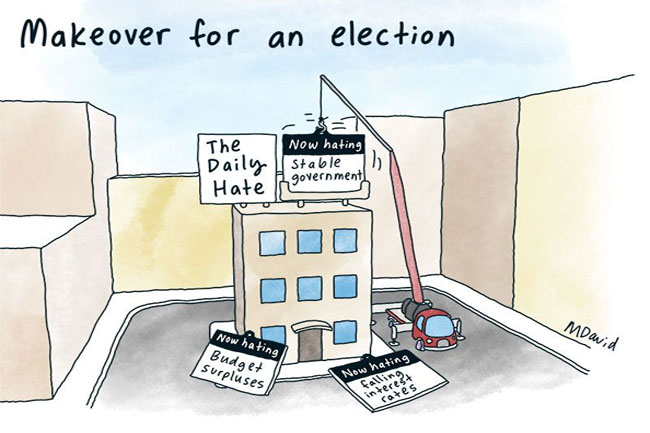Australia’s high job participation is not the cause for celebration the Morrison Government and the mainstream media want voters to believe it is, reports Alan Austin.
THE LATEST JOB participation figure of 66.3% was hailed by Treasurer Josh Frydenberg as a great achievement. It isn’t. The Australian Bureau of Statistics (ABS) reported a surge to a new record in March. This is, in fact, the result of two recent shifts caused by current policies.
Each of these warrants condemnation rather than self-congratulation.
To be clear, job participation is the total number of people in the workforce – working full-time and part-time and looking for work – as a percentage of the civilian population aged 15 years and over.
Retirees rejoining the workforce
The trend of seniors forced back to work first became apparent in 2018 when the Coalition ramped up its campaign against pensioners and other welfare recipients. This accelerated in 2020. Workers 65 and older have increased over the last four years from 466,200 to 648,200. That is now 15.1% of the population aged 65 and over.
Through the five years 2011 to 2015, the level was quite steady with an average of just 11.7%.
Why are those 182,000 seniors back at the factory, farm or office instead of gardening, fishing and playing with their grandchildren? Being unable to survive on the age pension is one reason. Having insufficient superannuation is another. Finding self-managed savings yield inadequate income now interest rates are close to zero would be one also. There are surely others.
Whatever the reasons, seniors no longer free to sleep in have increased the participation rate significantly. Without them, it would be 65.4%.
Students abandoning college
More disturbingly, Australians engaged in study in 2020 fell by 28,500 from 2019 enrolments. As a percentage of the population, this has tumbled from a peak of 12.75% in 2016 to 12.16% in 2020, the lowest level since 2009.
If students were still enrolled at the 2016 rate, another 152,000 Australians would be gaining skills and qualifications. Job participation would be down another 0.7%.
Optimum participation rate
So where should the rate be? This won’t be the same for all countries. For Australia, the optimum seems to be between 64.9 and 65.3.
How do we know that? Because that was the bracket for most of the period between August 2009 and August 2013 when Australia had the world’s best-performing economy and the highest global ranking for jobs ever.
That was the bracket for the entire period from December 2011, until Labor lost office in September 2013. when the economy was clearly the world’s strongest.
Annual GDP growth in June 2012 was 4.5%; wages were growing at 3.8%; the jobless rate at 5.16% ranked sixth in the OECD; median wealth was the world’s highest; economic freedom was the highest in the OECD; and Australia had just been awarded triple-A credit ratings with all three agencies for the first time.
Enrolments in education were at a solid 12.41%, and only 12.2% of seniors were working. The job participation rate in June 2012 was 65.1%. Pretty much the sweet spot.
Overseas experience
More than 20 countries are currently faring much better than Australia in overall economic outcomes. On six key variables – the jobless, GDP growth, wages growth, productivity, budget deficits and gross debt added in the last year – nine are stand-out leaders. These are Ireland, Taiwan, New Zealand, Norway, the Netherlands, Denmark, Estonia, Switzerland and South Korea.
These have varying labour participation rates, ranging from 59.2 to 71.8. But they have one feature in common. Current participation rate percentages are well below their peaks.
Ireland is at 61.3, down from levels above 66 a decade ago. South Korea is at 62.5, down from above 64 in 2019. New Zealand is at 70.4, down from recent rates above 71. Norway is at 70.6, in steady decline from highs above 74 a few years ago.
This bolsters the view that a well-managed economy allows seniors to retire at a higher rate than otherwise and encourages more students to stay in school.
The Treasurer notes that:
'The participation rate is at a record high ... our plan is working.'
Perhaps he doesn’t know his policies are forcing many Australians to rejoin the workforce – or dole queues – who should be occupied elsewhere. Perhaps he does.
It certainly suits big business to have as many people as possible, young and old, competing for jobs and keeping downward pressure on wages.
Alan Austin’s defamation matter is nearly over. You can read the latest update here and contribute to the crowd-funding campaign HERE. Alan Austin is an Independent Australia columnist and freelance journalist. You can follow him on Twitter @alanaustin001.
Related Articles
- CARTOONS: Mark David is never, ever to blame
- Sex, lies and iPhone pics: Scott Morrison’s imperfect storm
- The Liberal Love labyrinth
- The Morrison Government is on the nose
- Morrison missing the memo on climate change
 This work is licensed under a Creative Commons Attribution-NonCommercial-NoDerivs 3.0 Australia License
This work is licensed under a Creative Commons Attribution-NonCommercial-NoDerivs 3.0 Australia License
Support independent journalism Subscribe to IA.














